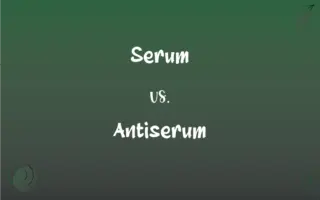Lubricant Glidant vs. Anti Adherent: What's the Difference?
Edited by Aimie Carlson || By Harlon Moss || Published on February 24, 2024
Lubricant glidants reduce friction during tablet processing, aiding in smooth machinery operation; anti-adherents prevent tablet sticking, ensuring proper tablet formation and ejection.

Key Differences
Lubricant glidants are used in tablet manufacturing to reduce friction between the tablet's surface and the machinery, such as dies and punches. This reduction in friction facilitates the smooth movement of tablets through the machinery, enhancing production efficiency. In contrast, anti-adherents are agents that prevent the adherence of tablet granules or powder to the machinery, particularly the punch faces and die walls, which is crucial for maintaining the integrity and uniformity of tablets.
The primary function of lubricant glidants, such as magnesium stearate, is to improve the flowability of granules or powder blends during tablet compression. This leads to consistent tablet weight and content uniformity. Anti-adherents, like talc or silicon dioxide, act by forming a barrier between the tablet material and machine parts, preventing sticking and picking issues that can lead to tablet defects and production downtime.
Lubricant glidants are typically added in small quantities towards the end of the tablet formulation process to minimize their potential impact on tablet disintegration and dissolution. Conversely, anti-adherents are often incorporated during the granulation or blending stage to ensure a uniform coating over the granules, effectively preventing sticking during the subsequent compression stage.
In terms of material properties, lubricant glidants usually have hydrophobic characteristics that help in reducing inter-particulate friction. Anti-adherents, however, are selected for their ability to create a non-stick surface, often having properties that allow them to coat or absorb excess moisture, which can contribute to sticking.
Both lubricant glidants and anti-adherents serve to enhance the manufacturing process of tablets, their mechanisms of action and points of application within the process are distinct. Lubricant glidants ensure smooth flow and compression, whereas anti-adherents focus on preventing material adherence to equipment, each playing a critical role in efficient and high-quality tablet production.
ADVERTISEMENT
Comparison Chart
Primary Function
Reduces friction
Prevents sticking
Typical Application Stage
Added before compression stage
Incorporated during blending or granulation
Common Examples
Magnesium stearate
Talc, Silicon dioxide
Impact on Production Process
Facilitates smooth machinery operation
Ensures clean tablet ejection
Role in Tablet Quality
Aids in flowability and uniformity
Maintains tablet integrity
ADVERTISEMENT
Lubricant Glidant and Anti Adherent Definitions
Lubricant Glidant
Lubricant glidant is added to pharmaceutical formulations to enhance machinery efficiency.
The lubricant glidant prevented the sticking of tablets to the equipment.
Anti Adherent
Anti adherent helps maintain tablet integrity by reducing sticking during production.
Adding an anti adherent ensured the tablets came out of the molds intact.
Lubricant Glidant
Lubricant glidant ensures uniform distribution of tablet ingredients during compression.
Incorporating a lubricant glidant helped in achieving uniform tablet composition.
Anti Adherent
Anti adherent creates a non-stick barrier between tablets and machine surfaces.
With an anti adherent, there was no sticking of the granules to the equipment.
Lubricant Glidant
Lubricant glidant assists in the smooth flow of granules in tablet manufacturing.
A lubricant glidant was crucial for maintaining consistent tablet weights.
Anti Adherent
Anti adherent is an agent preventing tablet material from sticking to processing equipment.
The anti adherent was effective in avoiding the adherence of tablets to the punch.
Lubricant Glidant
Lubricant glidant is a substance used to reduce friction in tablet processing.
The addition of a lubricant glidant eased the tablet's movement through the press.
Anti Adherent
Anti adherent aids in the clean ejection of tablets from compression machinery.
The anti adherent facilitated the smooth release of tablets without residue.
Lubricant Glidant
Lubricant glidant minimizes inter-particulate friction in tablet production.
The lubricant glidant played a key role in the smooth ejection of tablets from the dies.
Anti Adherent
Anti adherent is incorporated into tablet formulations to prevent material build-up.
The use of an anti adherent avoided clogging of the tablet press.
FAQs
What are common examples of lubricant glidants?
Common examples include magnesium stearate and stearic acid.
Where is a lubricant glidant applied in the tablet-making process?
A lubricant glidant is typically added just before the tablet compression stage.
At what stage are anti adherents added in tablet production?
They are usually added during the granulation or blending stage.
How does a lubricant glidant affect tablet production?
It facilitates the smooth operation of machinery and consistent tablet formation.
What is a lubricant glidant?
A lubricant glidant is a substance used in tablet manufacturing to reduce friction between the tablet and machinery.
Can lubricant glidants impact tablet dissolution?
Yes, excessive use of lubricant glidants can affect tablet disintegration and dissolution rates.
What are some examples of anti adherents?
Examples include talc and silicon dioxide.
Can anti adherents affect tablet weight?
No, anti adherents typically do not significantly affect tablet weight.
Can lubricant glidants be used in capsule manufacturing?
Yes, they can be used to improve capsule filling and prevent sticking.
Are there any alternatives to magnesium stearate as a lubricant glidant?
Yes, alternatives like sodium stearyl fumarate can be used.
What is an anti adherent?
An anti adherent is a substance used to prevent tablets from sticking to equipment during manufacturing.
How do anti adherents enhance tablet quality?
By preventing sticking, they ensure the integrity and proper shape of tablets.
Can the overuse of anti adherents lead to problems?
Overuse can potentially affect the mechanical strength and disintegration of tablets.
Is the quantity of lubricant glidant important?
Yes, the right quantity is crucial for effective lubrication without impacting tablet quality.
Are anti adherents used in all tablet formulations?
No, their use depends on the formulation and the tendency of materials to stick.
Do anti adherents have any nutritional value?
No, anti adherents do not provide nutritional value; they are used solely for manufacturing purposes.
Is compatibility testing necessary for lubricant glidants?
Yes, to ensure they don’t negatively interact with other tablet ingredients.
Can anti adherents affect the color or appearance of tablets?
Yes, some anti adherents might impart a slight color or affect the tablet's surface appearance.
Are there natural alternatives to synthetic lubricant glidants?
Natural alternatives like vegetable stearates can be used, though less commonly.
Are lubricant glidants and anti adherents safe for consumption?
Yes, when used in regulated amounts, they are considered safe for pharmaceutical use.
About Author
Written by
Harlon MossHarlon is a seasoned quality moderator and accomplished content writer for Difference Wiki. An alumnus of the prestigious University of California, he earned his degree in Computer Science. Leveraging his academic background, Harlon brings a meticulous and informed perspective to his work, ensuring content accuracy and excellence.
Edited by
Aimie CarlsonAimie Carlson, holding a master's degree in English literature, is a fervent English language enthusiast. She lends her writing talents to Difference Wiki, a prominent website that specializes in comparisons, offering readers insightful analyses that both captivate and inform.






































































